Semester projects for GEOG 369 Remote Sensing (Rowley) & ENVS 399 Sustainability Practicum (Krygier). OWU Science Center Atrium, Tuesday May 2, 2023.
ENVS 399 info: GEOG 369 Remote Sensing
Semester projects for GEOG 369 Remote Sensing (Rowley) & ENVS 399 Sustainability Practicum (Krygier). OWU Science Center Atrium, Tuesday May 2, 2023.
ENVS 399 info: GEOG 369 Remote Sensing
Time for interested students to apply for the Student Sustainability Coordinator position for the Fall of ’23 and Spring of ’24.
Apply on the STAP site, starting Tuesday, March 21.
Applications are due by Tuesday, April 4 at 11:59 p.m.
For the Fall of ’23: A glitch in our application means we don’t have STAP funding for the Fall, but plan to cover the position with ENVS funds. Duties include organizing the Sustainability Task Force meetings (three per semester, noon on Wednesday). Talk to Krygier
Spring ’24: You must apply for the Spring ’24 position, which is 6 hours a week paying $10.75 per hour. Please plan to organize the Sustainability Task Force meetings (three per semester, noon on Wednesday) and attend either or both of the ENVS 399 Sustainability Practicum course meetings (MW 2:10-4pm). Apply on the STAP site, starting Tuesday, March 21.
Details
STAP Internship Title: Student Sustainability Coordinator
Position Description: The Student Sustainability Coordinator position plays a vital role in maintaining and developing sustainability efforts on campus.
The student will organize and lead the campus Sustainability Task Force and liaise with the Environment & Sustainability Department (Anderson, Krygier, Rowley). Students in the position will also work with faculty, staff, and students (including those in Geography 399 & Geography 499) on campus sustainability projects. Typically, the student attends the 0.25 credit ENVS 198/498 Conversations Towards a Sustainable Future course and works with new ENVS students.
Students may engage with additional research projects with ENVS faculty, pursue environmental activism efforts, help manage OWU’s Green Week, May Move Out, and other initiatives. Two students who previously held the position were authors on research papers published in part based on work undertaken while in a STAP position.
Skills/Qualifications Required: Candidates should be organized, enthusiastic, and work well with others (students, staff, faculty). Experience with sustainability efforts on campus helps. Ability to maintain outreach and scheduling while working well without excessive oversight. Ability to use Google Drive apps, Doodle, etc. necessary. But who can’t do that?
Examples of Assignments/Duties: Sustainability Task Force (leadership, organization, content) in collaboration with Anderson, Krygier, Rowley. Assist with organization of May Move Out, Green Week, campus habitat enhancements (Chimney Swift Tower, bird habitats, etc.), recycling issues, food issues, composting, liaise with WCSA, Tree House, Citizens Climate Lobby, regional ROAR collaboration (Otterbein, Denison, Kenyon, etc.), City of Delaware, MTSO, Stratford, Preservation Parks.
Applications: Students interested broadly in the environment and sustainability. Environmental Science, Environmental Studies, Biological and Earth Sciences, P&G, Sociology, Nutrition, Psychology, etc. Future interests in environmental leadership, careers in the environment, graduate school
Unique Responsibilities: This position, as described above, is literal career training in that it requires passion and competence while allowing the student to pursue and develop important, practical skills. In addition, some previous students have used this position to engage in research, publication, and use the experience as a springboard to graduate school. Responsibility, leadership, motivation, and working for the better good of the environment and sustainability on campus and beyond are central to this position.
OWU Connection Experience: Mapping the impact of road salt on local freshwater ecosystems in Delaware County using ArcGIS, a type of online geographic information system software
Rancher has been working on an independent study project under the direction of Amy Downing, Ph.D., professor of Biological Sciences, with support from Nathan Rowley, Ph.D., associate professor of Environment and Sustainability, and John Krygier, Ph.D., professor of Environment and Sustainability and director of Environmental Studies.
The project is an expansion of research Downing conducted with scientists across North America and Europe to show the damage being done to freshwater lakes by salt concentrations that fall below the ranges government regulators have deemed safe for freshwater organisms.
“In this project,” Rancher said of his independent study, “we conducted an analysis to predict which ponds in Delaware County are most vulnerable to (road) salt exposure based on factors such as pond size, watershed size, distance from impervious surfaces, amount of impervious surfaces, and the amount of salt applied near a pond.”
“We connected with city and county departments to access data files such as digital elevation models (DEM), street centerlines, and aerial imagery, as well as to develop an understanding of how much salt is applied to which roads. At this point in time, we have been able to successfully apply this model to about five individual ponds, but the goal is to increase this amount to around 20 or more ponds and then go out and sample these ponds for chloride concentrations to compare to our predictions.
“The goal is to find a way to automate our analytical process in ArcGIS to allow us to develop a salt vulnerability assessment for all ponds in Delaware County and create a well-rounded map of the landscape. In theory, this might look something like a heat map where we score ponds based on our predictions for their vulnerability to salinization.
“For example, a pond with a high vulnerability might be scored a 10, correlated with dark red, and a low vulnerability pond might be a 1, associated with tan or yellow. In the end, our map may look different than this because we are dealing with hundreds of ponds and various factors that could sway a pond’s vulnerability to salt even to a degree. Therefore, this is something we must keep in mind in order to accurately represent and map our results.
“The intention would be to make the map accessible to the University and to the public through Arc Online once it is finalized.”
“Fall semester was very pivotal for me because I have gained confidence with ArcGIS and the research process, which I know will be very applicable in my graduate studies.
“There is always something that you are learning in the classroom that can have a real-world application, so I always try to approach a new class with this mindset and get something out of the experience.
“Moreover, independent research, whether it is by yourself and a professor or with a few peers and a professor, is a very genuine opportunity to develop hands-on skills and new interests/passions that you could then convert into your focus in graduate studies or even a career.”
“My favorite moment throughout this experience was witnessing first-hand how receptive individuals of city and county departments were and seeing their willingness to help me find the information I needed and well wishes for the project. This is very meaningful because you can tell they care about who we are as students and what we have to offer, and they are not here to act as a barrier but to help you break down barriers and learn as much as possible.
“There is a lot that could come out of continued connections between OWU and people who work for Delaware City and County departments, and a lot of good is to come with a greater connection with the Delaware community.”
Rancher and Downing have drafted a first article outlining the project, “Developing a predictive model for pond salinization using readily available geospatial data,” which they hope, ultimately, to publish in a scientific journal.
“If we can automate our processes and establish a significant correlation between our predictions and actual observed concentrations for ponds, then publishing a paper would be the next step. Our (fall) project did not involve any other students, but including students in the future to help develop the model more or to go out and collect data would be awesome whether it be this spring or in future semesters.”
“I chose Ohio Wesleyan because it was close to home so I could commute, and the campus was very beautiful.
“When I was looking into the University back in high school, I was unaware of the opportunities it would later provide me with. However, I am very grateful for my experience because of the close connections I have developed with peers and professors; opportunities to hone in on multidisciplinary skills in Science, Philosophy, and Spanish; and (ability to) conduct and present research through the OWU Connection and SSRP (Summer Science Research Program).”
“My plans after graduation are to enroll in a graduate program in Geography. I have applied to a few different master’s programs at universities in the U.S.
“Subsequent to my graduate studies, I really do not know what I want to do, but I would love to work in industry in a niche scientific field, either at a company that works on solving environmental problems out in the world, or at a company that needs more sophisticated understanding, recognition, and initiative towards its own environmental impact.
“To help me achieve my goals, OWU has provided me with a broad skill set and ability to problem-solve by considering multiple perspectives, and a stern objective to protect the welfare of future generations thanks to the motivations of various professors and a diverse course load that has interested and excited me.”
Shared from here
Savannah will be interviewed on the Mid Ohio Breakfast Club Radio Show on Friday, October 14 around 8:15am. The show airs weekdays from 6am-9am on My967 at 96.7 FM or AM 1270 WDLR.

DELAWARE, Ohio – As a high school student volunteering to clean up litter in her New York hometown, Savannah Domenech quickly realized that a coordinated, continuous effort involving lots of people was necessary to make the type of permanent, positive environmental impact she sought to achieve.
As an Ohio Wesleyan University student, Domenech, a sophomore from Webster, New York, found an opportunity to collaborate with the City of Delaware and the community to improve local water quality. This month, she is spearheading the launch of the city’s Adopt-a-Drain program that invites people to adopt storm drains and clean them regularly to prevent trash and other debris from entering area waterways.
“Be a stormwater hero – adopt a drain!” said Domenech, an Environmental Studies and Geography double-major. “Any person can agree to do a biweekly clean-up on and around a storm drain of their choosing within Delaware City.”
Those who choose to participate are improving the environment with “simple, quick actions” that will help to reduce localized flooding, improve stormwater quality, and enhance community and neighborhood cleanliness, she said.
Domenech began working on the Adopt-a-Drain project in her ENVS 110 (Introduction to Environment and Sustainability) class and has earned an OWU Connection grant to help her launch the Adopt-a-Drain program.
She is beginning the project in earnest this month by encouraging members of the OWU campus community to adopt drains to clean and maintain. In November, she plans to roll out the program to the larger Delaware community when a Stormwater Watch Quarterly newsletter will be mailed to residents with their utility bills and posters will be posted around downtown. More details and sign-up information are available online now at stormwater.owu.edu.
David Soliday, Ohio Wesleyan’s instructional technologist, was first in line to adopt a drain and help Domenech test the program’s protocols.
“I’m happy to help,” said Soliday, also a longtime member of the Sustainable Delaware environmental community group. “As an adopter, I’ll be keeping the drain clear of debris. This includes leaves in the fall, and any kind of trash or litter. I have committed to fill out a brief survey when I do, to track how much and what kind of debris I collect.
“These drains empty into the Olentangy River, which is the source of our tap water in the city,” said Soliday, who hopes others embrace the green initiative. “Excessive debris can clog the pipes, and otherwise complicate matters downstream, where the same river is a valuable resource for Worthington, Columbus, and other communities. My taking responsibility for this drain also helps raise awareness of our connection to the natural world around us.”
As people adopt drains, Domenech said, their “I’m adopted!” choices will be mapped online using the ArcGIS Online software.
Domenech’s project is being completed in collaboration with the City of Delaware’s Department of Public Utilities; Erin Wolfe, the city’s watershed and sustainability coordinator; and Ohio Wesleyan’s Department of Environment and Sustainability.
Press release below duplicated from here.
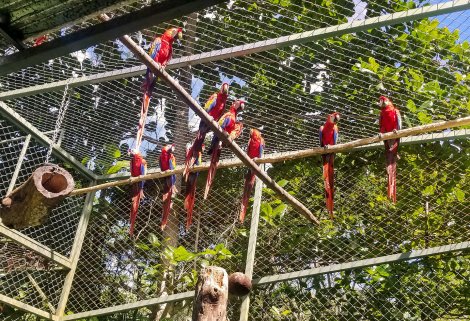

Name: Zynnia Peterson ’23
Hometown: Mt. Vernon, Ohio
Major: Zoology
Minor: Environmental Science
OWU Connection Experience: Volunteering with the Macaw Recovery Network in Costa Rica
Peterson volunteered with the Macaw Recovery Network’s Punta Islita Breeding Center for a month this summer. After she completed training, Peterson was able to help prepare food for captive and pre-release parrots, monitor their health and behavior, and ensure they had clean and safe living conditions.
Peterson earned an OWU Connection Theory-to-Practice Grant to support her Central American experience and received support in writing and editing her grant application from John Krygier, Ph.D., professor of Environment and Sustainability.
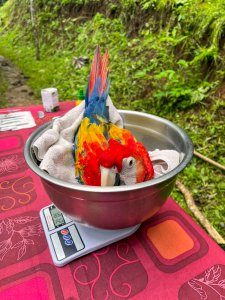
“Something I learned specific to parrot conservation is that human aversion and flight training are absolute musts when preparing a flock for release.
“Parrots, being more gregarious birds, can become used to humans in captivity and this can increase their likelihood of being recaptured after release unless they are taught that humans are actually scary, even though not all of them are.
“Flight training then also increases their strength and ability to fly long distances once released as well. A lot of it is just about promoting natural behaviors that parrots learn from other parrots and their environment. Since they’re more intelligent, they have to be taught these things through experience rather than via instinct alone.”
“I also learned that volunteering is a good way to travel. It gives you a group of like-minded people that you get to know really well as long as a safe space to go back to while you still have the ability to explore the local area on your days off.
“While I didn’t immerse myself in Costa Rican culture as I had hoped, I still had the opportunity to meet amazing people from all around the world and form close friendships.”
“My experience also helped me relax a little bit. I feel like it’s easy to get caught up in the busy lifestyle most Americans have, but being in Costa Rica and only having to worry about a bit of food management (we only drove to the grocery store once a week) and whether I had to do specific chores that day really gave me a new perspective on what I actually viewed as important.
“By the time I made it back home I was able to create new habits that serve me better than some of the wasteful and unpleasant habits I had before.”
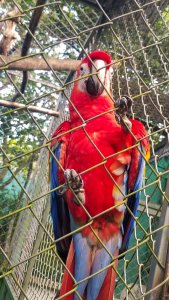
“Even though the purpose of my experience was to learn more about conservation, I would have to say my favorite moment was the night before a fellow volunteer was about to leave. She taught us all some Latin dances and then made Argentinean empanadas.
“Something I unexpectedly loved about my trip was how close you get to everyone on site, especially during our communal dinners. Everyone I met was an absolutely lovely human being, and I hope in the future we can someday meet again.”
“Unexpectedly my trip did involve an OWU alum. On my plane to Miami, I sat next to Mrs. Marcy Rodgers. She graduated (in 1982), and we were able to chat a lot on the plane and during my layover. She has a lot of experience traveling in Latin America, and she was very helpful and calmed some of my worries about traveling.”
“I chose OWU because of their affordability with GLCA (Great Lakes Colleges Association), smaller size, easier ability to connect with staff due to the smaller size, as well as their Zoology program.” (Ohio Wesleyan is a GLCA school, and Peterson’s father is employed by another GLCA school.)
“Until this summer, my future plans were to work in zoology with hopes of improving the pet trade for exotic animals like reptiles and parrots.
“I have been recently looking into requirements for science librarians due to my very enjoyable part-time job at my local public library, which complicates things a bit as far as the experience in conservation.
“No matter which path I choose, I think OWU has prepared me for either with skills in writing, networking, and the ability to work with others from different walks of life.”
September 29, 2022 ~ reposted from here
DELAWARE, Oh. – Several community members, leaders, schools and groups received recognition at the annual Keep Delaware County Beautiful Awards that occurred on Dec. 4 at Stratford Ecological Center.
The Litter Prevention Award recognized Ohio Wesleyan University student Brianna Graber who coordinated with the City of Delaware on a project to install a storm drain net in Delaware Run on the OWU Campus. The 6-and-a-half ton device is the first of its kind installed in the United States and collects trash and organic debris. The collected waste will be analyzed and the water quality will be monitored giving the community a better picture of the health of our water resources.
More on the storm drain net:
With climate change, water rights, and environmental politics dominating world discussions, Ohio Wesleyan University student Kayla Adolph ’20 of Toledo, Ohio, is addressing the issues on campus with a project 10 months in the making.
Collaborating with OWU students, faculty, and staff, as well as workers from the City of Delaware, Adolph spearheaded the installation of a rain garden this fall on the west side of Merrick Hall. The garden is the result of a project in professor John Krygier’s spring 2019 course, Geography 360: Environmental Geography.
More: Beauty and Function: Ohio Wesleyan Student Spearheads Creation of University’s Third Rain Garden
Ohio Wesleyan University senior Brianna Graber has spent the past year planning and conducting water-quality research on the Delaware Run, which flows through the university campus and into the Olentangy River.
Her work included collaborating with the City of Delaware to install a 4-foot-high, 18.5-foot-wide, concrete-weighted storm drain net directly into the waterway. Put in place by crane Sept. 9, the 13,000-pound trapezoidal net is now capturing trash and green debris (organic waste such as lawn clippings and leaves). The net is one of the first installed in Ohio and the nation.
More information: Net Benefits: OWU News & Media
Visit the storm drain net: then social media it: #delrunstormdrainnet
The storm drain net is accessible from the OWU campus, just east of the 2nd footbridge east of S. Sandusky St.:
A video of the storm drain net in Delaware Run (Sept. 25, 2019)
Rain last weekend started the process of filling the net and trapping stream debris just upstream from the net (below). An assortment of larger trash along with quite a large amount of organic material is evident. Most notable is the impressive collection of cigarette butts.
Brianna Graber (OWU 2020) has been testing Delaware Run water, and will be able to compare water quality before and after the storm drain net installation. Material caught in the storm drain net will be analyzed for content (organic vs waste, etc.). The effects of such larger water-bourne materials on water quality is the focus of Graber’s work.
The presence of so many cigarette butts is of interest. Not only do cigarette butts contain plastic, but they also contain chemicals including nicotine. Some studies have began to investigate the impact of nicotine and other contaminants from cigarette butts on urban water (see Littered cigarette butts as a source of nicotine in urban waters, Journal of Hydrology
Volume 519, Part D, 27 November 2014, Pages 3466-3474).
Analyzing the contents of the storm drain net will allow the City of Delaware and other collaborators to understand and create target efforts to reduce specific kinds of waste, and to understand how both human generated and organic waste effect water quality.
Watch here for updates and let us know if you have questions!
Students and faculty have been working a project to implement a storm drain net in the Delaware Run on campus. The purpose of the net will be to remove trash and green waste/debris from the Delaware Run behind Merrick on campus.
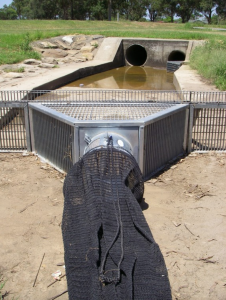 Beginning in the Fall of 2018, Janelle Valdinger, Dr. John Krygier and I (Brianna Graber) have been cohesively working a project to implement a storm drain net in the Delaware Run, on OWU’s campus. The purpose of this project will be for Summer Science Research through Ohio Wesleyan University and for an internship with the City of Delaware. The purpose of the net will be to remove trash and green waste/debris from the Delaware Run behind Merrick on campus.
Beginning in the Fall of 2018, Janelle Valdinger, Dr. John Krygier and I (Brianna Graber) have been cohesively working a project to implement a storm drain net in the Delaware Run, on OWU’s campus. The purpose of this project will be for Summer Science Research through Ohio Wesleyan University and for an internship with the City of Delaware. The purpose of the net will be to remove trash and green waste/debris from the Delaware Run behind Merrick on campus.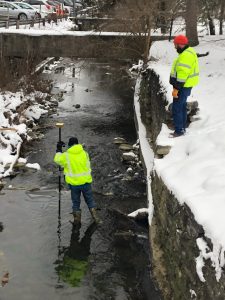
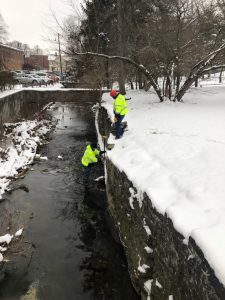
DELAWARE, Ohio – Ohio Wesleyan University student Janelle Valdinger is one of fewer than 20 undergraduate and graduate students across the country invited to participate in January in the first national Workshop on Community Geography.

DELAWARE, Ohio – Ohio Wesleyan University student Janelle Valdinger is one of fewer than 20 undergraduate and graduate students across the country invited to participate in January in the first national Workshop on Community Geography.
Valdinger, an OWU geography major, has been named a Community Geography Fellow and awarded funds to attend the two-day conference Jan. 25-26 at Georgia State University in Atlanta. According to organizers, the National Science Foundation-supported workshop will bring together 40 to 50 Community Geography Fellows, who are “academic researchers and community leaders interested in using geographic research for community development, social justice, and environmental sustainability.”
In addition to being a full-time Ohio Wesleyan student, Valdinger also is a full-time employee of the City of Delaware, where she works as a Geographic Information System (GIS) technician.
She said her main goals for the workshop include “learning new ways to use geographic research for community development, especially in other countries … and finding new ways to build a stronger, long-lasting working relationship between Ohio Wesleyan University and the City of Delaware.”
Valdinger already has helped to coordinate a joint university-city project to install three water-purifying rain gardens on OWU’s campus. She is helping now to implement a collaborative relationship that involves the city’s Department of Public Utilities hosting OWU students as interns and “developing a partnership with the OWU Summer Science Research Program where the city hires a student-intern for the summer and the university provides housing, along with faculty guidance for a research project.”
The first Ohio Wesleyan student to hold the summer research internship is junior zoology major Brianna Graber. Graber is working with the city this semester on a project to fund and install storm-drain nets to catch large waste items and prevent them from entering the Olentangy River.
While attending the Georgia conference, Valdinger will present information on the developing OWU-Delaware partnership, which currently includes eight university students working on environmental projects.
In addition, she hopes to glean information to assist with her Ohio Wesleyan departmental honors project, which focuses on mapping public utilities in Belize.
On campus, she is collaborating on the honors project with Department of Geology and Geography faculty members John Krygier, Ph.D., director of environmental studies; Nathan Amador Rowley, Ph.D.; and Ashley Allen, Ph.D., and with Jay Scheffel, assistant director of physical plant. Off campus, Valdinger is working with 2003 OWU alumnus Tim Hawthorne, Ph.D., assistant professor of GIS at the University of Central Florida.
“Not only will we be mapping utilities, but we will be providing utility locators to the local government officials in Belize,” Valdinger said. “Citizen Science will play a large role in this project, and learning (at the workshop) about what avenues other professionals have taken will help greatly in the execution of my project.”
Krygier, who was also named a Community Geography Fellow, said he is excited for Valdinger to attend the workshop and share her OWU accomplishments with scholars from across the country, and to learn how to further community engagement on campus, in Delaware, and abroad.
He also is excited by the overall potential of community geography, one of his research specialties, and its focus on engaged community work.
“It’s about creating a win-win situation for colleges and their communities,” Krygier said, “with positive impacts, research experiences, and real-world engagement between people and institutions who share many common goals.”
Learn more about the upcoming national Workshop on Community Geography at www.communitymappinglab.org/commgeog19.html and more about OWU’s geography major at www.owu.edu/geography or https://sustainability.owu.edu.